Exploring the impact and challenges of tele-ICU: A qualitative study on nursing perspectives
IF 2.2
4区 医学
Q1 NURSING
引用次数: 0
Abstract
Aim
The primary objectives of this study were to explore ICU and Tele-ICU nurses' perceptions of Tele-ICU, focusing on its perceived benefits, challenges, and implications for integration into critical care settings.
Background
Tele-Intensive Care Unit (Tele-ICU) services are reshaping critical care by enabling remote monitoring and enhancing patient outcomes. This study investigates the experiences of nurses transitioning from bedside ICU to Tele-ICU roles, focusing on the impact on patient care, organizational benefits, and implementation challenges.
Methods
A qualitative approach was used, involving semi-structured interviews with ICU nurses who transitioned to Tele-ICU roles. An interview guide was developed to explore key topics, including the benefits, challenges, and future implications of TeleICU. Thematic analysis was applied to identify recurring themes and subthemes.
Results
Participants highlighted several benefits of Tele-ICU, including continuous patient monitoring, improved infection control, and enhanced resource utilization. Organizational advantages included reduced length of stay, lower readmission rates, and improved post-discharge planning. However, significant barriers were identified, such as technological infrastructure issues, financial constraints, resistance to workflow changes, and gaps in training. Cultural preferences for in-person care and regulatory challenges were also noted.
Conclusions
Tele-ICU presents significant opportunities to improve critical care delivery, but its success depends on addressing implementation barriers. Investments in technology, comprehensive training, and supportive policies are essential for maximizing its potential and facilitating broader adoption in healthcare settings.
探讨远程icu的影响和挑战:护理视角的定性研究
目的本研究的主要目的是探讨ICU和远程ICU护士对远程ICU的看法,重点关注其感知的好处、挑战和对融入重症监护环境的影响。远程重症监护病房(Tele-ICU)服务通过实现远程监测和改善患者预后,正在重塑重症监护。本研究调查了护士从床边ICU角色过渡到远程ICU角色的经验,重点关注对患者护理的影响,组织利益和实施挑战。方法采用定性方法,对过渡到远程ICU角色的ICU护士进行半结构化访谈。我们制定了一份访谈指南来探讨一些关键话题,包括TeleICU的好处、挑战和未来的影响。专题分析用于确定反复出现的主题和次主题。结果参与者强调了远程icu的几个好处,包括患者持续监测,改善感染控制,提高资源利用率。组织优势包括缩短住院时间,降低再入院率,改善出院后计划。然而,重要的障碍被确定,例如技术基础设施问题、财政限制、对工作流程变更的抵制以及培训中的差距。还注意到面对面护理的文化偏好和监管挑战。结论ele- icu为改善重症监护提供了重要的机会,但其成功取决于解决实施障碍。对技术、全面培训和支持性政策的投资对于最大限度地发挥其潜力和促进在医疗保健环境中更广泛地采用它至关重要。
本文章由计算机程序翻译,如有差异,请以英文原文为准。
求助全文
约1分钟内获得全文
求助全文
来源期刊

Applied Nursing Research
医学-护理
CiteScore
4.50
自引率
0.00%
发文量
65
审稿时长
70 days
期刊介绍:
Applied Nursing Research presents original, peer-reviewed research findings clearly and directly for clinical applications in all nursing specialties. Regular features include "Ask the Experts," research briefs, clinical methods, book reviews, news and announcements, and an editorial section. Applied Nursing Research covers such areas as pain management, patient education, discharge planning, nursing diagnosis, job stress in nursing, nursing influence on length of hospital stay, and nurse/physician collaboration.
 求助内容:
求助内容: 应助结果提醒方式:
应助结果提醒方式:


